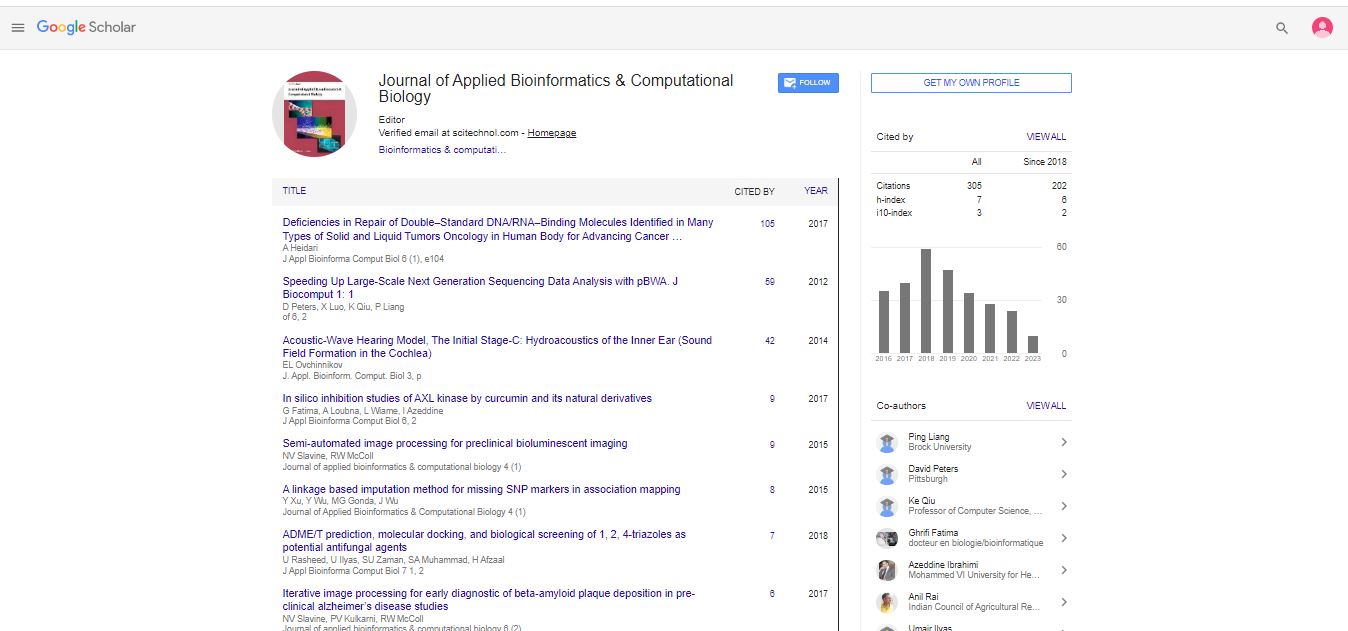Perspective, Vol: 14 Issue: 1
Evolutionary Tapestry: A Deep Dive into Comparative Genomics
Nabya Singh*
Department of Chemistry, Ahmadu Bello University, Kaduna State, Nigeria
*Corresponding Author: Nabya Singh,
Department of Chemistry, Ahmadu Bello University, Kaduna State, Nigeria
E-mail: singhn59@gmail.com
Received date: 20 February, 2024, Manuscript No. JABCB-24-127922;
Editor assigned date: 22 February, 2024, PreQC No. JABCB-24-127922 (PQ);
Reviewed date: 04 March, 2024, QC No. JABCB-24-127922;
Revised date: 22 April, 2025, Manuscript No. JABCB-24-127922 (R);
Published date: 29 April, 2025, DOI: 10.4172/2329-9533.1000295
Citation: Singh N (2025) Evolutionary Tapestry: A Deep Dive into Comparative Genomics. J Appl Bioinforma Comput Biol 14:1.
Introduction
In the vast realm of biological sciences, one field stands out as a beacon of understanding: Comparative genomics. It's the scientific art of peering into the intricate blueprints of life, unraveling the genomic signatures that define and distinguish different organisms. From the microscopic bacteria to the majestic creatures of the savannah, every life form has a story inscribed within its DNA. Comparative genomics is the key that unlocks these narratives, allowing scientists to decipher the secrets of evolution and biodiversity.At its core, comparative genomics is about comparison. It involves the meticulous examination of genetic material across species to identify similarities, differences, and patterns. By comparing genomes, scientists can discern the genetic features that are conserved throughout evolutionary history and those that have diverged to shape the diversity of life we see today.
Description
One of the primary objectives of comparative genomics is to understand the mechanisms driving evolutionary change. By analyzing the genetic variations between species, researchers can infer the processes of mutation, selection, and genetic drift that have sculpted the tree of life over millions of years. This insight not only sheds light on the past but also provides valuable clues about the future direction of evolution.
Furthermore, comparative genomics plays a crucial role in deciphering the genetic basis of traits and diseases. By identifying genes that are shared or unique to particular species, scientists can pinpoint genetic factors underlying specific biological functions or diseases. This knowledge is invaluable for biomedical research, offering new targets for drug development and insights into human health and disease.
One fascinating aspect of comparative genomics is the study of model organisms. These are species with well-characterized genomes that serve as experimental platforms for studying fundamental biological processes. From the humble fruit fly to the ubiquitous mouse, model organisms provide valuable insights into the workings of genes and their interactions. By comparing the genomes of model organisms to those of other species, scientists can uncover evolutionarily conserved mechanisms that govern key biological phenomena.
Moreover, comparative genomics extends beyond individual species to entire ecosystems. By analyzing the collective genomes of organisms within an ecosystem, researchers can gain insights into ecological relationships, adaptation, and ecosystem dynamics. This approach, known as meta-genomics, has revolutionized our understanding of microbial communities, revealing the hidden world of microorganisms that play essential roles in the functioning of ecosystems.
In recent years, advances in sequencing technology have propelled comparative genomics to new heights. The advent of high-throughput sequencing has enabled researchers to sequence entire genomes quickly and cost-effectively, paving the way for large-scale comparative studies. As a result, the field of comparative genomics is experiencing a renaissance, with an explosion of genomic data fueling discoveries across the biological sciences.
However, with great power comes great responsibility. The deluge of genomic data presents significant challenges in terms of analysis, interpretation, and ethical considerations. As researchers grapple with the complexities of big data, they must also navigate ethical dilemmas surrounding genetic privacy, data sharing, and the implications of their findings for society.
Despite these challenges, the future of comparative genomics is bright. With each new genome sequenced, we gain a deeper understanding of the genetic diversity and evolutionary history of life on Earth. Armed with this knowledge, we are better equipped to address pressing challenge
 Spanish
Spanish  Chinese
Chinese  Russian
Russian  German
German  French
French  Japanese
Japanese  Portuguese
Portuguese  Hindi
Hindi 
